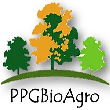Banca de QUALIFICAÇÃO: TATIANE DEOTI PELISSARI
Uma banca de QUALIFICAÇÃO de MESTRADO foi cadastrada pelo programa.DISCENTE : TATIANE DEOTI PELISSARI
DATA : 25/12/2021
HORA: 14:00
LOCAL: Unemat
TÍTULO:
Soy in the Brazilian Amazon
PALAVRAS-CHAVES:
Deforestation; Soy Moratorium; Land Use Change; Livestock
PÁGINAS: 60
GRANDE ÁREA: Ciências Biológicas
ÁREA: Biologia Geral
RESUMO:
Livestock and soy are the main drivers of deforestation in the Brazilian Amazon. The purpose of this work was to verify the conversion of natural areas for soy planting after the Soy Moratorium, between the crop years 2009/2010 to 2017/2018. To evaluate the deforested areas, images were used via remote sensing of the Landsat satellites made available by the Global Forest Change database, with files containing 8-bit values, with a spatial resolution of one second of arc per pixel, or approximately 30 meters per pixel in the equator. The areas cultivated with soy were identified with the PCEI index (Perpendicular Crop Enhancement Index). Boxplots were built to demonstrate the variation of the variables evaluated over the time series. To check the trend of variables over the years, the Man-Kendall test was applied, followed by the Pettitt test to identify the probable point of change with the significant trend at 0.005 for the Pettitt test. All analyzes were performed with R software with the aid of the “ggplot2”, “trend”, “ManKendall” and “factoextra” packages. In the 2017/2018 crop year, soy was present in seven Amazonian states, with the exception of Amazonas and Maranhão and occupying an area of 5,237,640 hectares (ha). The states with the largest planting areas were Mato Grosso (4,453,053 ha), Pará (565,541 ha) and Rondônia (95,934 ha). The states with the largest areas of deforestation were Pará and Mato Grosso and the trend test showed that the probable year of change was 2006 for the state of Mato Grosso, which coincides with the year of implementation of the Soy Moratorium. As of 2009, 12,413,267 ha have been deforested. Of this total, 359,606 ha were converted into soybean areas. This represents only 2.90% of all deforestation in the Amazon in the period. Our results show that cattle ranching remains the main driver of deforestation in the Amazon and that the public policies that have existed so far have not been sufficient to contain deforestation.
MEMBROS DA BANCA:
Presidente - 131948001 - MENDELSON GUERREIRO DE LIMA
Interno - 210865003 - GUSTAVO CAIONE
Externo à Instituição - PAULO EDUARDO TEODORO - UFMS



